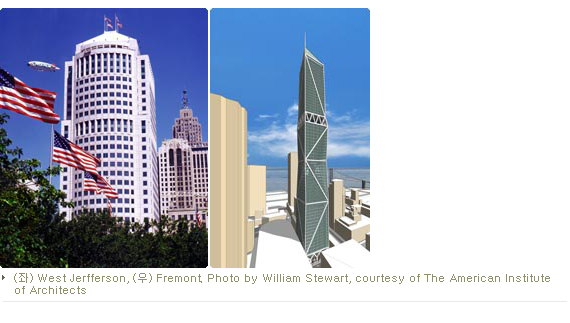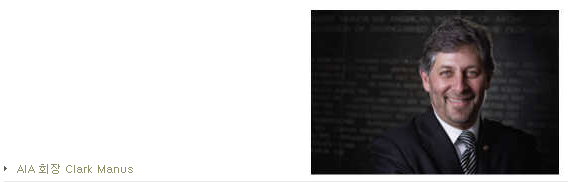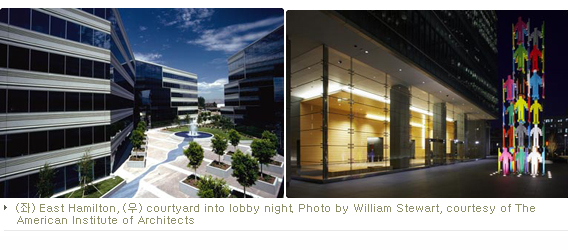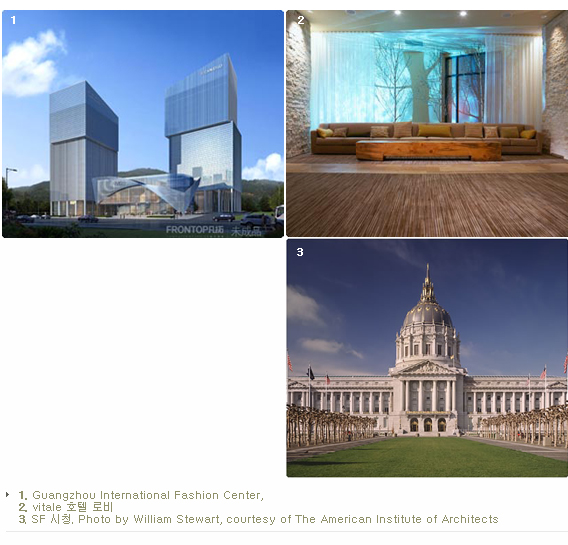Designing Resilient Communities _ Sustainable Survivability
2011-08-17
지속 가능성에 대한 논의는 불가피하게 에너지 문제와 직접적으로 연결된다. 우리가 환경문제와 현대 문명생활의 충족 사이에서 어떻게 균형을 맞추는가는 것은 당연히 전문건축가들이 풀어야 할 문제이다. 그 이유는 최근 세계의 에너지의 불균형에 있어서 건물에 의한 소비가 대부분이기 때문이다. 클라이언트와 정부가 에너지의 저감 솔루션이 건축디자인의 문제라는 것을 이해함에 따라 새로운 건물의 신축과 개축에 있어 해결점을 함께 모색해야 하고 있고 실제 그렇게 하고 있다.
글 | Clark Manus
인터뷰 | 윤혜경 연세대 연구교수
여기서 또한 건축가들은 대두되는 대중들의 공공참여, 재해에 대한 대응방안을 알리고 더 나아가 궁극적으로 그 재난에서 회복할 수 있도록 안내하는 것을 포함하는 리더쉽을 발휘해야 한다. 이 세 가지에 대해 자연재해와 관련된 위험에 대한 공공의 인식을 불러일으키는 데 있어서의 전문건축 분야들이 그 역할을 성공적으로 이루어내는 것이 가장 중요할 것이다. 이 점은 대부분 중요시 취급되지 못하였는데 그 이유는 대중과 의사 결정자들이 주로 미래의 잠재성을 예측하는 것에 관심을 두었기 때문이다.
만약 공공의 지식이 아직 부재하다면, 다음 자연재해 사고 이전에 사회의 회복에 있어 실제적 투자를 지원하는 것과 같은 중요한 정치적 동의를 모으는 것이 불가능하게 될 것이다. 지리학자들, 기후학자들과 협력하여 건축가들은 그러한 동의를 모으도록 해야 한다. 과학자들은 하드 데이터를 제공하고 건축가들은 그 데이터를 그것이 다음 지진, 허리케인, 쓰나미 또는 홍수이든 간에 피할 수 없는 심각한 자연 재해의 충격을 완화시키는데 도움이 되는 안 을 제공하는 시나리오 내에서 데이터를 해석하여야 한다. 잠재적인 자연재해의 충격에 대한 공공의 인식과 이해를 도모하는 것은 위험에 대한 철저한 평가를 필요하다. 위험의 모습은 지역에 따라 차이가 있을 것이다. 한국의 지리는 일본의 지리에 비해 심각한 지진의 발생빈도가 비교적 낮은 반면, 한반도는 파괴적인 태풍의 바람과 폭우에 의한 자연피해 가능성이 있다.
하지만 위험 평가가 공포를 동반하는 전략적 무기가 되어서는 안 된다. 만약 공포를 제거한다면 전략적 무기는 더 이상 효과가 없게 된다. 본인은 일본과 다르지 않는 지진활동 지역에서 살고 일하고 있다. 그럼에도 불구하고 필자나 이곳에 살고 있는 사람들은 아무도 두려워서 캘리포니아를 떠나려고 하지는 않는다. 필자는 대부분의 한국인들도 마찬가지라고 생각한다. 고장에 대한 강한 애착심은 우리 모두가 나누고 있는 문화이다. 모든 문화는 대부분의 심각한 자연 재해가 일어날 수 있는 고장에 살기를 종종 선택해 왔다. 우리가 이사 가려고 하지 않기 때문에 우리가 살고 있는 고장에 관련된 위험에 대한 인식은 우리의 집이 서울이든 샌프란시스코이든 자연 재해에 대응할 수 있는 지역적 디자인 전략을 이해하는 것과 더불어 그 정보를 적극적으로 옹호하고 받아들이는 데 장려책이 되어야 한다.
정확하고 이해력 있는 위험 처리의 부재나 그러한 정보를 의도적으로 무시하는 것은 심각한 자연 영향을 불가피하게 증폭시키고 그 사건을 재산상 또 인명상 더 큰 값을 초래하는 잠재력이 있는 인간이 만든 재난으로 변형시킨다. 비극은 여기에 있는데 모두가 함께 방지하지 하거나 그러한 재난을 완화시키는 것은 우리의 힘에 달려 있다는 것이다. 미국인들에게 있어, 분명한 예는 허리케인 카트리나의 재난을 목격한 사람들이고 그러한 재해는 뉴올리언스 주변의 습지를 수십 년 동안 잘못 관리하고 도시를 보호하기는커녕 불필요하게 시민들을 큰 위험에 노출시키는 잘못 설계된 운하와 제방 시스템의 결과로 일어났던 것이다. 이러한 고찰에서 암시하는 것은 지속 가능한 지역사회는 자연재해의 위험을 분석하는 데에는 물론 인명과 재산을 보호할 적절한 디자인 해답을 형성하는 데 있어 통합된 지역적 접근을 요구한다. 이것은 어떻게 각 건축가가 대응하느냐 이상의 고찰을 의미한다. 그것은 만약 하나의 구조가 돌무더기 바닥에 잘 이루어진다면 별로 중요하지 않을 것이다.
지역적, 통합적 조망에 대한 적용은 우리로 하여금 우리의 지역사회가 이웃 도시나 지역에 찾아온 재해로부터 제외될지라도 그러한 사건의 경제적 영향은 처음 재해의 차이를 훨씬 넘어서까지 번질 수 있다는 점에서 우리를 경각시키기도 한다. 우리가 일본을 바라보고 허리케인 카트리나의 후를 목격하면서 그것은 이로 인해 직접적으로 영향을 미치지는 않더라도 국가의 삶의 질을 떨어뜨려 경제적인 어려움의 불안을 불러 일으켜 전체 인구의 교체를 초래할 수 있다.
영문학 시인 죤 돈에게서 종종 인용되는 ― “섬에는 아무도 없다” ― 는 점차 더욱 서로 연관되는 우리의 세계에 있어 우리 모두에게 적용된다. 이 행성에서 우리의 여행은 우리 이웃과의 모임에 있다. 우리를 이 여행으로 인도하는 지도를 개발하는 것은 모든 발생했던 위험과 가능성으로 미래를 다 같이 상상할 수 있도록 우리에게 도전하고 우리가 나아가기 전에 우리의 선택에 무게를 싣는다. 그것은 건축과 디자인적 성찰이 이 가능성을 보여주는 데 도움이 되도록 할 수 있는가에 대한 도전이 될 것이다.
Discussions of sustainability inevitably focus on energy. How we strike a balance between the environment and the demands of modern civilization is of course a pressing concern that calls on the expertise of architects, since buildings currently consume a disproportionate share of the world’s energy. Our profession can and is increasingly making a positive difference, both in new construction and retrofits, as clients and government come to understand that energy use is a design issue.
However, as the magnitude of the Japan earthquake continues to unfold, it’s clear that sustainability embraces more than energy use and the attendant issue of climate change. A truly comprehensive approach to the challenge of sustainability must also take into account how the built environment responds to the broader environment, particularly the impact of natural disasters.
Here, too, architects have a leadership role to play, including raising public awareness, informing disaster response, and, ultimately, guiding recovery. Of these three, the success of our profession in raising public awareness to the risks associated with natural disasters may be the most important. It is also likely to be the most neglected since it requires the public and decision-makers to imagine a range of future potentials.
Yet in the absence of an educated public, it will be difficult if not impossible to develop the necessary political consensus to support a meaningful investment in a community’s resilience before the next natural disaster strikes. Architects in collaboration with geologists and climatologists must lead the effort to develop such a consensus—scientists to provide the hard data; architects to interpret the data in scenarios that offer prudent options likely to mitigate the impact of inevitable extreme natural events, whether they be the next earthquake, hurricane, tsunami, or flood.
Elevating the public’s awareness and understanding of the potential impact of natural disasters entails a thorough assessment of risk. The nature of the risk will of course vary from region to region. The geology of South Korea is such that compared to Japan the incidence of severe earthquakes is relatively low. On the other hand, the Korean peninsula is no stranger to the devastation occasioned by the wind and water of destructive typhoons.
Risk assessment, however, should not be a weapon for scare tactics, if for no other reason than as a tactic it seldom works. I live and practice in a seismically active zone not unlike that of Japan. Nevertheless, neither I nor my neighbors will be scared into moving out of California. I assume the same is true for most Koreans. The strong attachment to place is something we share with all cultures, and all cultures have often chosen to build in places prone to the most extreme natural disasters. Since we are not about to move, knowledge about the risks inherent in the places in which we live, whether our homes are in Seoul or San Francisco, should be an incentive to vigorously advocate and facilitate the adoption of codes in addition to comprehensive regional design strategies capable of coping with natural disasters.
Absent accurate and comprehensive risk assessments or a willful disregard of such information inevitably amplifies the impact of extreme nature, transforming an event into man-made disasters that have the potential of exacting a far higher price on property and human lives. The tragedy here is that such disasters are within our power to mitigate if not to prevent altogether. For an American, the obvious example is the devastation attendant on Hurricane Katrina, a catastrophe waiting to happen as a result of decades of mismanagement of the wetlands around New Orleans and an ill-designed system of canals and levees that far from protecting the city, unnecessarily exposed its citizens to great risk.
Implicit in this line of thinking is that sustainable communities require an integrated, regional approach not only in analyzing the risks of natural disasters, but also in shaping appropriate design solutions that will protect human lives and property. This means thinking beyond how individual buildings will respond. It will matter little if a handful of structures perform well in a carpet of rubble.
Applying a regional, integrative perspective also alerts us to the fact that even though our community may be spared the devastation visited on a neighboring town or province, the economic impact of such events can stretch far beyond the margins of the initial devastation. It can, as we are seeing in Japan and witnessed after Hurricane Katrina, result in the displacement of entire populations, raising the specter of economic hardship on those not immediately affected and diminishing a nation’s quality of life.
A frequently quoted line from the English poet John Donne—“no man is an island”—applies to all of us in our increasingly interconnected world. Our journey on this planet is in the company of our neighbors. Developing a map to guide us on this journey challenges us to imagine together the future with all its attendant risks and possibilities and then weigh our options before we proceed. It is a challenge that architects and design thinking are uniquely equipped to help show the way.
Clark Manus
Clark D. Manus, FAIA is the 2011 President of the American Institute of Architects (AIA) and CEO of San Francisco-based architecture and urban design firm Heller Manus Architects. For more information, visit www.hellermanus.com.





















